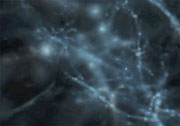- Number 338 |
- May 30, 2011
Not your typical Milky Way

Cosmic dust and dark matter
gather together in this image
from a computer simulation of
galaxy formation. Full credit:
Visualization/Simulation: Busha,
Kaehler, Marshall,
Wechsler/SLAC National
Accelerator Laboratory.
It was astronomers who taught humans the tough lesson that we are not the center of the universe, at least not literally. Our planet, our stars and our galaxy are similar to countless others. Or so it seemed. New research by scientists at the Kavli Institute for Particle Astrophysics and Cosmology (KIPAC) at SLAC National Accelerator Laboratory and Stanford University shows our home galaxy belongs to a rare subset among the billions that populate the cosmos.
"We've always been interested in how the Milky Way fits into the broader context of the universe," said Risa Wechsler, assistant professor at Stanford University and researcher at KIPAC, who led the research team. "This research helps us understand whether our galaxy is typical or not."
To build their analysis, the researchers dug deep into a tremendous volume of data from the Sloan Digital Sky Survey, the most extensive survey of the optical sky performed to date, to create a census of galaxies in our universe. The work represents one of the most extensive studies of this kind ever performed.
The study, published in the May 20 issue of the Astrophysical Journal, compared the Milky Way with galaxies similar to it in luminosity (the amount of light it emits in a given amount of time) and distance to other bright galaxies. Among the more than 200,000 considered, our galaxy belongs to a rare four percent that have two satellite galaxies as bright and close by as our two closest neighbors, the Large and Small Magellanic Clouds. Another 11 percent have one satellite galaxy similar to the Clouds, while 81 percent have none. In this way, the Milky Way differs from more than 95 percent of all galaxies to which it should appear nearly identical.
Their results were surprising, though not extreme. In cosmology, an idea named for Renaissance astronomer Nicolas Copernicus-who first posited that Earth is not the center of the universe-suggests that matter in the cosmos is relatively uniform in all directions, and generally homogeneous across vast swaths of space.
"The Copernican Principle implies that the Milky Way should look like a galaxy chosen at random from the general galaxy population," said KIPAC postdoc Brian Gerke, co-author on the paper. "But since galaxies, like people, are extremely diverse in their properties, it should not be surprising if our particular home galaxy is a bit unusual in at least one respect. In this sense, the Magellanic Clouds may be like the Milky Way's big ears or crooked nose, a bit strange, to be sure, but not necessarily any weirder than what you might find in any other galaxy."[Melinda Lee, 650.926.8547,
melinda.lee@slac.stanford.edu]
